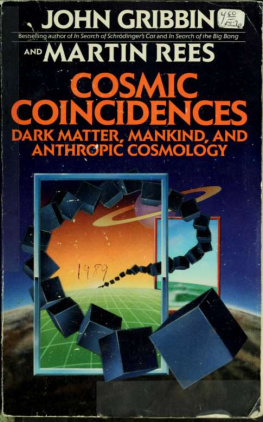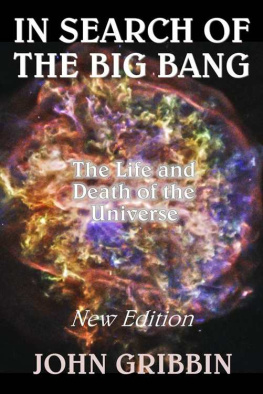PENGUIN BOOKS
STARDUST
Dr John Gribbin trained as an astrophysicist at the University of Cambridge before becoming a full-time science writer. He has worked for the science journal Nature, and the magazine New Scientist, has contributed articles on science topics to The Times, the Guardian and the Independent, and has made several acclaimed science series for BBC Radio 4. John Gribbin has received awards for his writing in both Britain and the United States and is currently a Visiting Fellow in Astronomy at the University of Sussex. In 1999 he was elected Fellow of the Royal Society of Literature. His many books include In Search of Schrdingers Cat, Stephen Hawking: A Life in Science (with Michael White) and In Search of SUSY. John Gribbin is also the author of several science fiction works including Innervisions. He is married with two sons and lives in East Sussex.
JohnGribbin
STARDUST
with MaryGribbin

PENGUIN BOOKS
PENGUIN BOOKS
Published by the Penguin Group
Penguin Books Ltd, 80 Strand, London WC2R 0RL , England
Penguin Putnam Inc., 375 Hudson Street, New York, New York 10014, USA
Penguin Books Australia Ltd, Ringwood, Victoria, Australia
Penguin Books Canada Ltd, 10 Alcorn Avenue, Toronto, Ontario, Canada M4V 3B2
Penguin Books India (P) Ltd, 11, Community Centre, Panchsheel Park, New Delhi 110 017, India
Penguin Books (NZ) Ltd, Cnr Rosedale and Airborne Roads, Albany, Auckland, New Zealand
Penguin Books (South Africa) (Pty) Ltd, 5 Watkins Street, Denver Ext 4, Johannesburg 2094, South Africa
Penguin Books Ltd, Registered Offices: 80 Strand, London WC2R 0RL , England
www.penguin.com
First published by Allen Lane The Penguin Press 2000
Published with a new Preface in Penguin Books 2001
Copyright John and Mary Gribbin, 2000
All rights reserved
The moral right of the author has been asserted
Except in the United States of America, this book is sold subject to the condition that it shall not, by way of trade or otherwise, be lent, re-sold, hired out, or otherwise circulated without the publishers prior consent in any form of binding or cover other than that in which it is published and without a similar condition including this condition being imposed on the subsequent purchaser
ISBN: 978-0-14-194130-1
Ay, for twere absurd
To think that nature in the earth bred gold
Perfect i the instant; something went before.
There must be remote matter.
Ben Jonson
The Alchemist
Acknowledgements
I am grateful to Virginia Trimble for reading and commenting on the entire text; although I did not always take her advice, this feedback considerably improved the historical presentation of my story. Thanks also to Jonathan Gribbin for his usual efficient work on the illustrations for this book.
Contents
Introduction:
Our Place in the Universe
Chapter 1
Life and the Universe
Chapter 2
Life as We Know It
Chapter 3
The Stars are Suns
Chapter 4
Inside the Stars
Chapter 5
Cycles and Chains in Stars
Chapter 6
Big Bang Cookery
Chapter 7
Burbidge, Burbidge, Fowler and Hoyle
Chapter 8
The Superstar Connection
Chapter 9
Sowing the Seed
Appendix:
Across the Universe(s)
List of Colour Illustrations
Preface to the Penguin Edition
You Read It Here First!
In January 2001, scientists from NASAs Ames Research Centre and the University of California, Santa Cruz, surprised many of their colleagues and created headline news by announcing the results of experiments carried out in laboratories here on Earth which produced complex organic molecules under conditions resembling those which exist in interstellar clouds of gas and dust. In these experiments, a mixture of the kind of icy material known to exist in those clouds (composed of water, methanol, ammonia and carbon monoxide frozen together) was kept in a cold vacuum and dosed with ultraviolet radiation. Chemical reactions stimulated by the radiation (typical of the kind of radiation from young stars which zaps real interstellar clouds) produced a variety of organic compounds which, when immersed in water, spontaneously created membranous structures resembling soap bubbles. All life on Earth is based on cells, bags of biological material encased in just this kind of membrane. The implication of this work is that space is filled with chemical compounds which can easily give a kick-start to life if they land in a suitable environment, such as on the surface of the Earth. The comets which proliferate in the outer part of our Solar System and occasionally pass through the inner regions near the Earth are known to be made of almost pristine interstellar material left over from the formation of the Sun and planets out of one of these interstellar clouds. It seems very likely, therefore, that any planet like the Earth will be seeded with the raw materials necessary for life almost as soon as it forms. The discovery was headline news at the time, and seems to have taken the researchers themselves by surprise. In the issue of the Independent dated 30 January 2001, Lou Allamondola, the leader of the team, was quoted as saying we expected ultraviolet radiation would make a few molecules that might have some biological interest, but nothing major. Instead, we found that this process transforms some of the simple chemicals that are very common in space into larger molecules which behave in far more complex ways, which many people think are critical to the origin of life. But these researchers, and the journalists so eager to write their headlines, might have been less surprised by the discovery, and the implications for the origin of life on Earth, if they had kept up to date with the story told in this book. There is nothing new, as you will see, with the idea that complex organic material is built up in space from simple atoms and molecules by the action of ultraviolet radiation; nor is there anything new in the suggestion that these precursors of life may have been brought down to earth by comets. Indeed, the story is better presented as an example of the classic scientific method at work. The work described in the original edition of this book essentially provided the basis of a prediction, that complex molecules (and even cell-like structures) must exist in the kind of interstellar clouds from which planetary systems like our own form. That prediction has now been born out by experiment, which elevates the status of the ideas described here from that of a mere hypothesis to that of a fully fledged theory. There now seems very little room to doubt that life must be a common occurrence across the Universe (which is not quite the same thing as saying that intelligent life is common). To find out why, read on.
John Gribbin
2 March 2001
Introduction:
Our Place in the Universe
Life begins with the process of star formation. We are made of stardust. Every atom of every element in your body except for hydrogen has been manufactured inside stars, scattered across the Universe in great stellar explosions, and recycled to become part of you. The hydrogen is primordial material, produced in the Big Bang, along with helium (there is no helium in your body). Hydrogen and helium together formed the raw material for the first generation of stars, some 12 billion years ago, but everything else has been built up by nuclear fusion in stellar furnaces.
Next page










